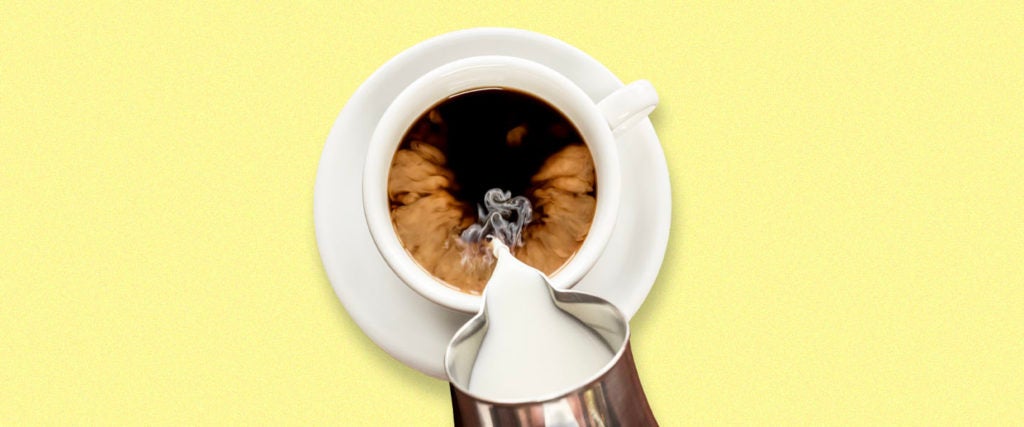Call me a savage, but I’m the type of guy who takes his coffee with six Splendas in it. After all, what am I trying to accomplish by pretending I have some ultra-refined palate, or faking like I’m willing to settle for a beverage that smells 15 times more delicious than it truly tastes? At the same time, I’ve never understood the allure of coffee creamer (probably because I’ve never had a problem with coffee’s texture). Meanwhile, my teenage nephew loves to pour himself cups of “coffee” that appear to be at least 50 percent creamer. (Maybe everyone in my family is a savage?)
Regardless of how you prefer to adulterate your favorite cup of joe, if you’re looking to cut calories in as painless a way as possible, you may be staring down that bottle of coffee creamer, hoping that by sacrificing it, you won’t have to sacrifice something much more delicious later on. (Anything with cream in the name — ice cream, whipped cream, cream cheese — is gonna be loaded with calories and fat, right?) So what are your creamer options in terms of both losing weight and maximizing the taste and smoothness of your morning coffee?
What Actually Qualifies as a Creamer?
First, we need to agree to some basic terms. By definition, the breed of coffee creamer we’re describing was invented to function as a non-dairy creamer. Theoretically, it was designed to replace products like evaporated Carnation milk, which was occasionally advertised as “grand coffee creamer” in the early 1950s. In almost every use of the term coffee creamer over subsequent decades, “coffee creamer” was specifically used to reference “non-dairy coffee creamer.”
What’s my point? Simply this: If you lump garden-variety milk or half-and-half in with coffee creamers, you’ve missed the point entirely. The category for “coffee creamer” — which is apparently what advertisers agreed to trim the appellation of “non-dairy coffee creamer” down to — was specifically constructed to exclude milk and half-and-half. Hey, I don’t make the rules; I just deliver the facts.
So, for our purposes, we’ll be evaluating two classes of items: 1) liquid coffee creamers, which are composed primarily of oil; and 2) powdered coffee creamers, which are also composed primarily of oil (admit it — you’re shocked).
Got It. So Which Coffee Creamer Will Help Me Lose Weight?
Again, let’s make sure we’re even asking the correct question by breaking things down a bit further. When coffee creamer isn’t purchased in large quantities, it’s typically parceled out into minuscule single-serving plastic containers that are humorously called “tubs.” A classic 0.375 ounce container of coffee creamer delivers an average of about 10 calories.
Practically speaking, if you flavor your four-ounce cup of coffee with a single tub of coffee creamer, you’re adding a portion of calories to your drink that most people can dispose of by jogging — or in some cases, walking briskly — for one minute on a treadmill, or through engaging in 60 seconds of virtually any other form of moderately intensive cardiovascular exercise. I’m not kidding. Take the stairs instead of the elevator one time, or park as far away from the Target as possible. Either way, the detrimental effects of the coffee creamer have been mitigated, and the creamer crisis has been contained.
Don’t misunderstand me: I am absolutely intending to make light of this. The only way those 10 calories could conceivably become a problem for most people, or make any discernible difference in the quality of their physiques, would be if they drank 10 or more cups of coffee per day containing this amount of creamer. If this is your life, you probably have other issues that need addressing, starting with your chronic over-caffeination.
But I Really Like Creamer!
Now, if you’re more like my nephew, and your creamer consumption is less easily measured in creamer tubs and more easily measured in bathtubs, there’s no doubt that your cream-oriented indulgences are going to have serious ramifications for your waistline.
Say for the sake of argument that you’re the sort of monster whose standard four-ounce cup of coffee is composed of one part coffee and one part creamer. A quart (32 ounces) of standard Coffee Mate hazelnut creamer contains 63 servings at 35 calories per serving. Very roughly, this is around 70 calories per ounce, so adding two ounces to your drink means that 140 calories are being conveyed to your body through every four-ounce dose of “coffee” that has now been transformed into a hot, watery slice of cake. Four of these four-ounce beverages per day will have you consuming the sugary equivalent to 64 ounces of Coke.
If you were wondering why your waistline had expanded to larger dimensions following your conversion to a low-calorie drink like coffee, we may have just ID’d the perp who has been secretly smuggling weight onto your belly.
If you absolutely must consume vast quantities of coffee, and that coffee absolutely must taste like a boiling McDonald’s milkshake, consider substituting an artificial sweetener for at least some of that creamer.
Stop Lecturing Me Already and Make a Recommendation!
Alright! Sugar-free coffee creamer is typically in the realm of 10 to 15 calories per tablespoon. If you substitute this for the fully-loaded stuff, you’d be reducing your caloric intake due to coffee creamer by at least half in most cases. But let’s be real: If coffee creamer is the true archnemesis of your nutrition plan, either you’re using the creamer wrong, or you’re using the coffee wrong.

